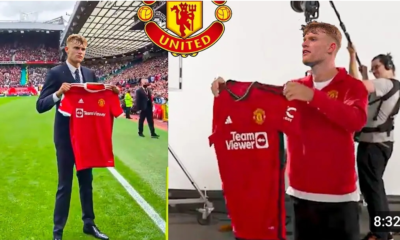Blog
“Transfer Portal Chaos: Is College Football on the Brink of Collapse? Experts Warn of an Unprecedented Crisis!”
Transfer Portal Chaos: Is College Football on the Brink of Collapse? Experts Warn of an Unprecedented Crisis!
As the college football landscape evolves, the recent surge in athlete movement through the transfer portal has raised significant concerns among fans, coaches, and administrators. With millions of players seeking new opportunities in the ever-expanding world of college athletics, experts are questioning the long-term implications of this trend. Is college football on the brink of collapse due to the chaos surrounding the transfer portal? In this in-depth analysis, we will explore the factors contributing to this alarming situation, the impact on programs and players, and the potential future of the sport.
#### Understanding the Transfer Portal Phenomenon
The NCAA transfer portal was introduced in October 2018 as a means to provide greater freedom and flexibility for student-athletes wishing to transfer between schools. This new system allows players to register their intent to transfer, making it easier for other colleges to contact them. Initially, the portal aimed to provide athletes with more options to find better fits for their academic and athletic goals. However, the unintended consequences of this implementation have created a turbulent environment for college football.
Since its inception, the transfer portal has exploded in popularity, with thousands of players entering each year. The COVID-19 pandemic and the NCAA’s decision to allow an additional year of eligibility for all athletes only exacerbated the situation, leading to an unprecedented influx of transfers. This rapid movement has left many programs scrambling to adapt, creating an unstable atmosphere that has left both players and coaches feeling uneasy.
#### The Impact on College Football Programs
For many college football programs, the transfer portal has become a double-edged sword. While it provides the opportunity to acquire talented players who can make an immediate impact, the challenges are equally significant. The most pressing concerns revolve around roster management, team chemistry, and the recruitment of high school prospects.
**1. Roster Management and Instability**
Coaches are finding it increasingly difficult to manage their rosters effectively, given the frequent turnover of players. The average number of transfers per program has risen sharply, which makes it challenging to maintain a cohesive team dynamic. Coaches must continually adapt their strategies and playbooks to accommodate new players, creating an environment where stability is hard to achieve.
**2. Disruption of Team Chemistry**
The influx of transfers can significantly disrupt the chemistry and culture of a team. When multiple new players join a squad, existing team members must adjust to new dynamics, which can lead to tensions both on and off the field. Building the trust and camaraderie essential for success in college football takes time, and constant changes hinder this process.
**3. High School Recruitment Consequences**
As more players enter the transfer portal, coaches are faced with a dilemma: investing time and resources into recruiting high school prospects or focusing on acquiring established talents from other programs. This shift threatens to undermine the traditional recruitment pipeline, which has long been the backbone of college football. The elevated risk of losing high school recruits to the appeal of immediate playing time elsewhere raises concerns about the future of youth development in the sport.
#### Players: A Double-Edged Sword
For student-athletes, the transfer portal has provided unprecedented opportunities, but it’s also fraught with challenges. The power dynamics have shifted, placing more control in the hands of the players. While this autonomy can lead to positive outcomes, it also raises ethical questions about loyalty, commitment, and the true meaning of being a student-athlete.
**1. Freedom vs. Commitment**
With the freedom to transfer without penalty, some players may view their initial commitments as less significant. This newfound autonomy has ignited debates about player loyalty and the importance of long-term commitments. Critics argue that the ease of transferring may lead to more players jumping ship at the first sign of adversity, negatively impacting the integrity of the sport.
**2. Pressure to Perform**
For players who transfer, the pressure to perform and justify their decision can be immense. Many face high expectations from coaches, fans, and themselves, which can lead to performance anxiety and struggles regarding identity and self-worth. In some cases, players may find themselves worse off after transferring if they fail to meet these expectations.
**3. Uncertainty in Career Development**
While the transfer portal can be a pathway to career development for many, it is also fraught with risks. Not every player finds success following a transfer; some may find themselves sitting on the bench or struggling to adapt to a new system. The uncertainty surrounding their future can be a heavy burden for young athletes to bear.
#### The Expert Perspective: Are We Facing a Crisis?
Many experts in the field of college athletics have weighed in on the potential crisis stemming from the transfer portal chaos. Their opinions highlight the urgency of the situation, emphasizing the need for reevaluation and reform.
**1. The Need for Policies and Regulations**
Some experts argue that the NCAA should implement policies and regulations to provide guidelines for the transfer process. A more structured approach could help mitigate the current chaos, balancing the needs of players while minimizing destabilizing effects on programs. This could include measures like transfer windows, which would allow for more orderly transitions.
**2. Concern Over Player Welfare**
With increasing concerns surrounding player welfare, experts emphasize the importance of providing support for athletes during their transition periods. Schools must invest in services that guide student-athletes through the complexities of transferring, both academically and socially. Creating comprehensive transition programs will foster a supportive environment for players navigating these significant changes.
**3. The Future of College Football**
The current trajectory raises fundamental questions regarding the future of college football as an organized sport. If the transfer portal continues to breed instability, could we see a decline in attendance at games, as fans grow weary of an ever-changing roster? Some analysts suggest that without taking immediate action, we may witness the erosion of the traditional college football experience—a once-stable environment that fostered loyalty and continuity.
#### Conclusion: The Path Forward
The transfer portal’s impact on college football is undeniably profound. While it provides avenues for player freedom, the ensuing chaos raises legitimate concerns about the sport’s future. Roster instability, disrupted team dynamics, and shifting recruitment strategies threaten to create a tumultuous landscape.
As the NCAA, coaches, and players navigate this uncharted territory, it is critical to consider the long-term implications of these rapid changes. Implementing regulations and support structures, while encouraging a sense of commitment among student-athletes, will be key to restoring balance to the college football experience.
If left unchecked, the current chaos surrounding the transfer portal could lead to a crisis that fundamentally alters the fabric of college football. The challenge remains to find a middle ground that retains the spirit of competition while acknowledging and supporting the individual needs of student-athletes in this new era. Only time will tell if the world of college football can adapt and thrive amidst the shifting tides.
-

 Arsenal2 years ago
Arsenal2 years agoSad News Arsenal ex player who is goal scorer confirmed dead this morning
-

 Liverpool2 years ago
Liverpool2 years agoSad News Sadio Manè Confirmed Dead Today By Sky Sports Reporters, Open For Full Story 👇
-

 Blog1 year ago
Blog1 year ago“I was forcefully removed from Manchester United squad and now I’ve joined the best team in the world…I will revenge and as a result, I’ve ordered my friend who’s their best player currently to leave there with immediate effect and he has agreed”: Former Man United player angered by United decision to removed him from the squad as he ordered the Club’s best player to leave immediately.
-

 Blog1 year ago
Blog1 year agoSad News: Manchester United player died when playing for his country England yesterday 😢 😔
-

 Blog2 years ago
Blog2 years agoR.I.P: Formal Real Madrid and France international confirm death this morning
-

 Chelsea2 years ago
Chelsea2 years agoBreaking New:”Roman Abramovich could get Chelsea back”? Chelsea owner review the conversation between him and Roman Abramovich in. Deal about getting Chelsea back
-

 Blog2 years ago
Blog2 years agoUNBELIEVABLE: Manchester City midfielder KELVIN DE BRUYNE divorced wife this morning after DNA test revealed their 5 years old son belongs to formal Manchester United player
-

 Manchester United1 year ago
Manchester United1 year agoOFFICIAL NOW: Manchester United announce the signing of 23yr sensational player after beating Liverpool and Madrid for His signature, agreement reached on a 5yr deal, Medical completed – announcement ongoing












